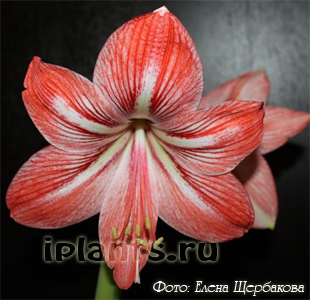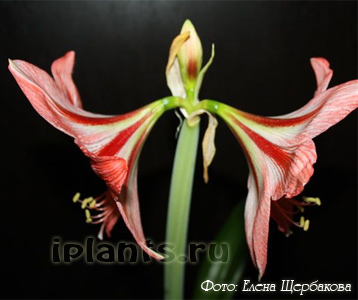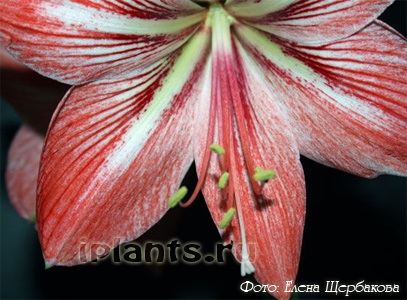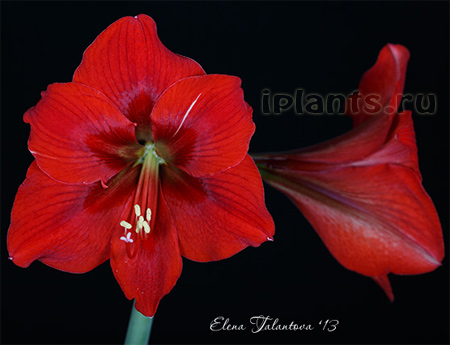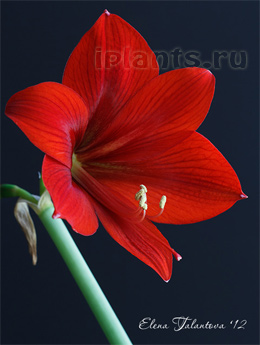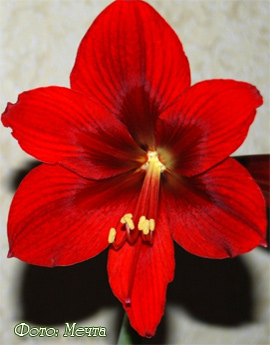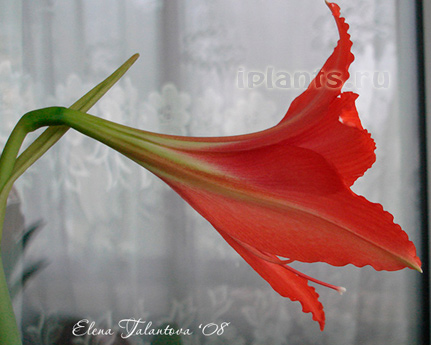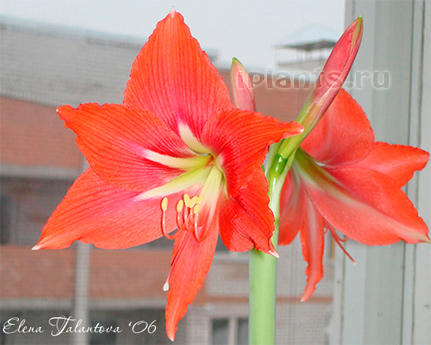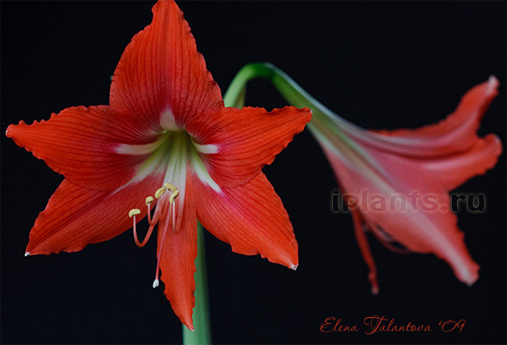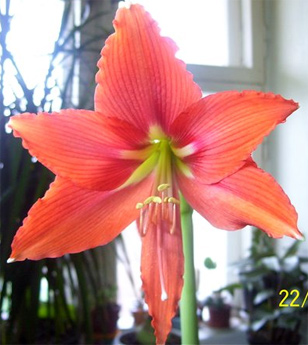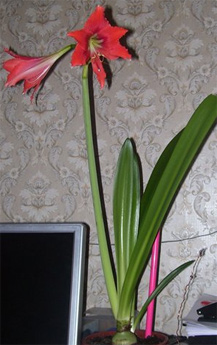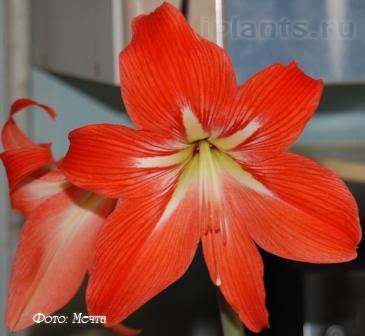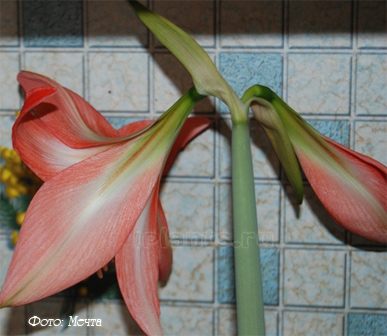The idea of writing this article came to life after a hot debate in the forum topic "Why should we not give names to grandmothers' hippeastrums"? A voting had also been organized. The aim of the article includes giving a go to avoiding some myths about the names of (so-called) old unnamed hybrids.
Where did these nameless old hybrids come from? The answer to this question can be obtained by looking at the history of the spread and hybridization of Hippeastrum. Hippeastrum study began in the late 18th century. Botanists William Herbert, John Gilbert Baker and later Hamilton, Paul Traub and others, made a huge contribution to the study, descriptions, classification, and development of Hippeastrum wild species. Found in nature, Hippeastrum species were taken to famous Botanical Gardens for further study and use in hybridization.
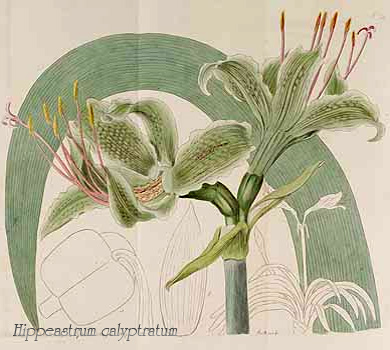
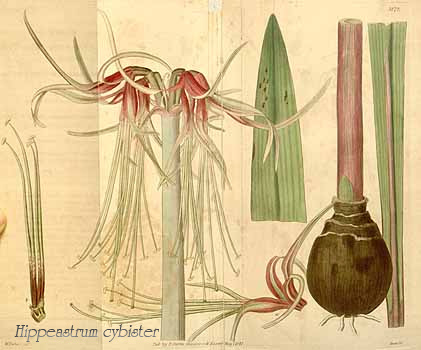
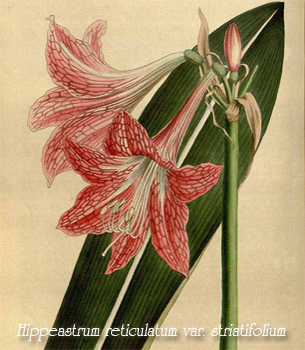
So far, about 80 species of Hippeastrum found in the wild tropical and subtropical regions of Peru, Bolivia, Argentina, Portugal, Brazil, Venezuela have been described by botanists.
Home hybridization was initiated in 1799. By crossing Hippeastrum reginae x Hippeastrum vittatum they got the first hybrid that received the official name Hippeastrum x johnsonii in honor of the originator, English clockmaker Johnson.
Hippeastrum is not only interesting in the terms of botany, but also gardeners, by the mid-19th century, had got more than 100 varieties. Hippeastrums got widespread in the Netherlands, the UK, the USA and Australia. To Russia, Hippeastrum had been imported since the middle of the 19th century.
The world interest in the genus has been increasing year in year out. Hybridization has been carried out in Holland, England, the USA, South Africa, Israel, Japan, Latin America, etc. By crossing species and / or high-grade Hippeastrums, originators (the people who are engaged in breeding new varieties) annually receive hundreds, if not thousands seedlings. Of these seedlings, only the best ones are selected.
The selection takes place according to certain criteria. While creating a new variety, the originator sets a task before them. That is to get some unusual flower color and shade , or a certain size (giant, or vice versa - a miniature ), or increase the number of flowers at the flower stalk , or get a strong, stable blooming , stress resistance variety (resistance to diseases, pests), etc. In practice, the best seedlings are rare in numbers, the rest are discarded. A proper originator destroys all bad seedlings.
For further use of the best seedlings, the originator submits an application for registration of the variety. A registered seedling becomes grade, getting a unique name. The registration procedure is complex and not all the seedlings get through it successfully. The question arises, what is this registration needed for? The answer is simple - to avoid conflicts.
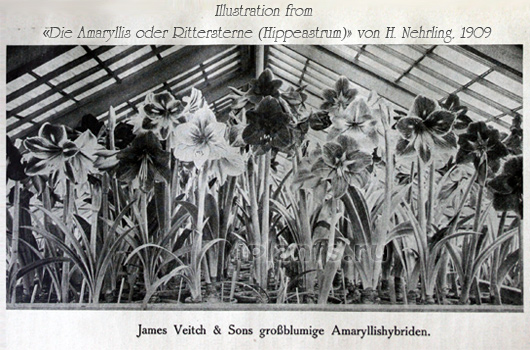 Hybrids from the famous kennel James Veitch & Sons in London
Hybrids from the famous kennel James Veitch & Sons in London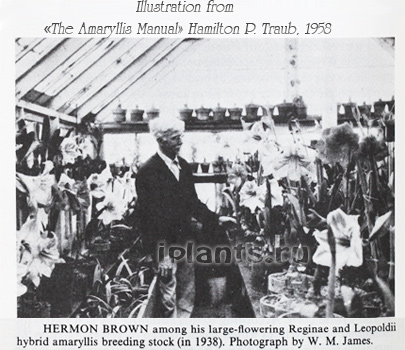 Leland Hermon Brown collector of hybrid amaryllis (hybrid Reginae Рё Leopoldii)
Leland Hermon Brown collector of hybrid amaryllis (hybrid Reginae Рё Leopoldii)The question arises, what is this registration needed for? The answer is simple - to avoid conflicts.
Here is an example:
Situation 1. Let's take two famous originators, (let's name them Originator 1 and Originator 2). These originators get separately engaged in breeding Hippeastrum varieties. In the course of their work they obtain excellent results, and they give the same name to the seedlings. These seedlings (under the same name) hit the market, and some time later, buyers themselves and the originators understand that different varieties have been bred , and they are sold under the same name.
Situation 2. Those originators get very similar hybrids, and give them different names. The flowers are absolutely similar, and they are sold under different names. The result is improper again, an awkward situation - angry customers , the problem of the first originator, which of them has the right to sell it, etc.
So, to avoid such embarrassing situations, and to have all things settled down in breeding varieties, they created an organization that registers and maintains a huge variety registration roster. This register prescribes basic characteristics of the variety (size, color, flower shape, morphology of the flower and others), the parents of the variety, the originator's name, the date of registration, some information about the originator's name and the variety. This register uses unique, non-repeating names. According to the rules you can not use the name of an already registered variety in the registry. Even if the names of the old varieties have been lost.
Nowadays, KAVB (Koninklijke Algemeene Vereeniging voor Bloembollencultuur = Royal General Bulb Plant Manufacturers' Association) is the international registration authority (ICRA) of new varieties of plants: tulips, hippeastrums, hyacinths, crocuses, muscaris and irises.
After registration, the originator can get a patent for the commercial use of this variety. The patent protects against theft of intellectual property and gives the right to the commercial use of this variety on a large scale.
But not all originators go this way. First, the procedure for registering is an expensive pleasure, it is rather long and there is no guarantee that the seedling will be registered, i.e. they can find reasons due which registration will be denied. Second, there is no guarantee that the monetary costs and the time spent will pay off - the variety may sell poorly. Third, there are fans of this culture who make pollination procedures for fun. Usually those fans do not understand the basics and problems of selection; they do not destroy discarded seedlings, but distribute them among friends nevertheless. They do not realize that these bad seedlings lead to the spread of global disorder. It will take some time and this bad seedling will be examined to see in it a variety, or a "species rarity," which was strangely inherited from a grandmother or aunt , and then donated.
Now we are talking just about the nameless hybrids. Basically, they are either rejected or unregistered seedlings or lost old varieties.
And the collections of Russian Hippeastrum amateurs have those "old grandmothers' hybrids" quite often. The name "Grandmothers" was given by Russian Hippeastrum fans. Their selection story is clueless, and concerning the origin, the owners say, "We got them from grandmothers of the Soviet era." These "grandmothers' hybrids" have distinguishing characteristic traits but they do not have a name (or they had been lost). That's why we decided to collectively give the name and description to these varieties.
Since we do not have any information about the originators, and the variety authentity, one can not say if these "grandmothers' hybrids" are varieties. We have no right to give official names to these varieties, because official names can be given by only an organization that registers them. We, a team of hippeastrum amateurs, give an informal name with the acronym Not Official Name (NON) and make up a brief description of the hybrid. If the authorship information about the variety is found, the name of the originator will be corrected to be official.
Here's the description of a "grandmothers' Hippeastrum", that the group of hippeastrum amateurs (at the portal iplants.ru) have given an informal name "The Creole Lady" (NON) to.
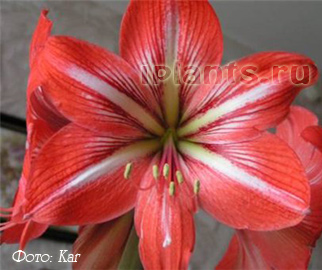
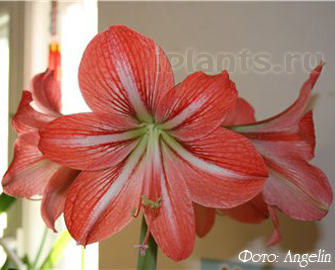
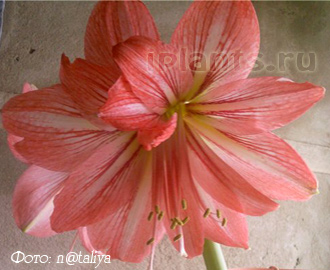
The unofficial name: "Creole Lady (NON)".
Origin: so far there's no exact information about the origin of Hippeastrum "Creole Lady (NON)"; and one cannot be sure that all similar (in phenotype) plants are clones of a single plant, i.e., they have the same parents. We cannot be sure that the plant is not propagated from seed, so similar plants are described as a hybrid group similar in phenotype.
Originator: Unknown
Date of the unofficial name assignment: 1/7/2013.
Who gave the name: conceptual organizer Elena Shcherbakova. The naming was done after the voting by the members of the forum organized by the team at portal iplants.ru
Classification: simple, intermediate (Medium).
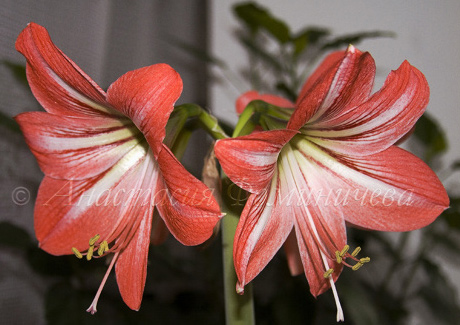
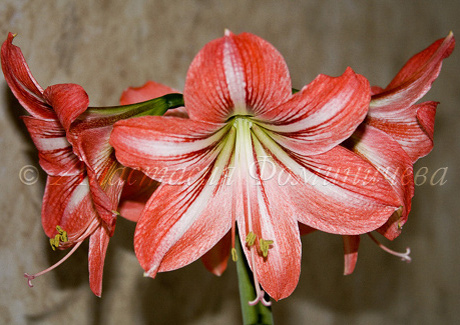
The main flower color: monochromatic colored flower with a light star in the throat. The colour is variable, from light pink-orange to red-orange. The main color is applied in two stages: the petals are pale orange, the veins are dark red-orange. One can come across a lighter clone, i.e. the main shadow is light, the veins are red-orange.
The number of flowers per flower scape: 3-5
Flower shape: flattened, pretty wide open, with a short perianth tube.
Petals: oval, with pointed tips. In a complete dissolution, the petals are curved.
Flower size:10 to 16 cm in diameter.
Description for this hybrid was made by Elena Shcherbakova:
This hippeastrum hybrid is of unknown origin from the ex-Soviet times. It produces bulblets freely, bulbs start to bloom with a diameter of 6-7 cm. Bulbs are round-oblong, the scape is 40-45 cm high. The scape is green without a tan colour; the flower's diameter is 15cm. The flower has distinct veining and orange stripes, with the characteristic light star, which extends from the throat of each petal, cut a little before reaching the edges. The star has a more pronounced red border, there is a bit in the throat, the throat with a slight greenish tinge; the filaments and style are not fully painted, white at the throat base, filament ends are lighter when closer to the anthers, the stigma is white, colour transitions are smooth. Flowers are three or four in number, seed pods are green. The anthers are small, pollen is yellow. Flower scapes appear with foliage simultaneously.
The unofficial name: "Garnet Bracelet" (NON)
Origin: So far, there's no exact information about the origin of this Hippeastrum and one cannot be sure that all the plants similar in phenotype are clones of a single plant, i.e. they have the same parents. We cannot be sure that the plant has not been distributed by seed, so similar plants are described as a hybrid group similar in phenotype.
Originator: Unknown
Date of assignment of the unofficial name: 21/10/2013.
Who was the name given by: conceptual group organizer Elena Talantova. The naming was done after the voting by the members of the forum organized by the team at portal iplants.ru
Classification: simple, intermediate (medium).

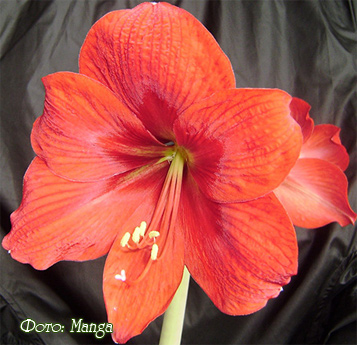
The basic color of the flower is dark red with pronounced veining. The color varies from red to ruby. In the throat, the red is often weak and the throat can be yellowish-green.
The number of flowers on the flower scape: 3-4.
Flower shape: the shape of the flower is open, with a short perianth tube.
Petals: ovate-oblong. In a complete dissolution, the petals are curved.
Flower size: 10 to 15 cm.
The description for this hybrid was made by Elena Talantova:
The flower is of rich red color with dark red veining. The colour varies from red to ruby. In the throat, the red is often weak and the throat can be yellowish-green. The bulb starts to bloom when reaching more than 5.5 cm in diameter. The number of flowers on the flower scape is 3-4. The average height of the stalk is 50-55 cm. The flower size in the complete dissolution is 10-15 cm. The segment sizes: - the "sail " is 4-5 cm, the "wings" are 3-4 cm, the "paddle" is 3-4 cm, the " tongue " is 2-3 cm. The flower size, the width of the petals and the ripple highly depend on the age and the forcing.
Young and weak bulbs may bloom in half size, with small flowers and narrow petals. The petals are ovate-oblong, pointed at the tips; in the dissolution they are curved. The flower shape is funnel-shaped, open. Column pestle filaments are red, closer to the throat they are yellow-green, the stigma is white. The pollen is yellow, of average fraction. The leaves are green with a tan closer to the bulb, the height is about 50-60 cm , 3.5-5 cm wide. The bulb is round, with brown scales. Bulb production is easy.
The unofficial name: "The Fife of Satire (NON)"
Origin: So far, there's no exact information about the origin of this Hippeastrum and one cannot be sure that all the plants similar in phenotype are clones of a single plant, i.e. they have the same parents. We cannot be sure that the plant has not been distributed by seed, so similar plants are described as a hybrid group similar in phenotype.
Originator: Unknown
Date of the unofficial name assignment : 21/10/2013
Who was the name given by: conceptual organizer Elena Talantova. It was named after the voting by members of the forum conducted by the iplants.ru team portal.
Classification: simple, intermediate (Medium).
The basic flower color: red-orange
The number of flowers per flower scape: up to 4 flowers
Flower shape: funnel-shaped, elongated
Petals: ovate-oblong, pointed at the tips, curved when in the dissolution. At the tips of the petals there are white "claws".
Flower size: about 15 cm
Description for this hybrid was made by Elena Talantova:
The flower is of orange-red color with a pale yellow star in the throat, in the full dissolution, they are with finely wavy edges on all petals. The bulb starts to bloom when the diameter exceeds 5 cm. There are usually 4 flowers at the flower scape, the average height of the peduncle is 50-60 cm. The flower size in the complete dissolution is about 15 cm, the segments are 2-4-5 cm, the lower segment is the narrowest. The lobes are ovate-oblong, pointed at the tips, curved in the dissolution. At the tips of the petals there are white "claws." The flower is funnel-shaped, elongated, and open. From aside, the flower looks very elegant due to the elongated funnel. The column pestle and filaments are colored red to the middle; from the middle of the throat they are of light green colour, the stigma is white. The pollen is yellow, of midi fraction. The leaves are green with a slight tan closer to the bulb, the height is about 60 cm, about 5 cm wide. The bulb is rounded, with brown scales. Bulb production is easy.
The unofficial name: " Wonderful Paddles (NON)"
Origin: So far, there's no exact information about the origin of this Hippeastrum and one cannot be sure that all the plants similar in phenotype are clones of a single plant, i.e. they have the same parents. We cannot be sure that the plant has not been distributed by seed, so similar plants are described as a hybrid group similar in phenotype.
Originator: Unknown
Date of the unofficial name assignment: 21/10/2013
Who was the name given by: conceptual organizer Elena Talantova. It was named after the voting by members of the forum conducted by the iplants.ru team portal.
Classification: simple, intermediate (Medium).
The basic flower color: red-orange with a bright star in the throat and dark red bit.
Number of flowers at the flower scape: 2-4
Flower shape: the shape of the flower is open; the length of the perianth tube is average.
Petals: oval-oblong, pointed at the tips.
Flower size: 12-15 cm
Description for this hybrid was made by Elena Talantova:
The flower is of orange-red color with a light star in the throat and dark red bit, with wavy edges. The bulb starts to bloom when the diameter exceeds 4.5 cm, the number flowers at the flower scape is 2-4, the flower stalk is 40-50 cm high on the average. The size of the flower in full dissolution is about 12-15 cm. The petals are heavy curved. The three outer segments ("the sail" and "the paddles") are oval-oblong, pointed at the tips. The three inner petals (the "wings" and the "tongue") are of narrower elongated shape with pointed tips. The flower shape is funnel-shaped, open. The Column pestle filaments are shorter than segments. They are painted yellow from the throat to the middle; they are red from the middle to the stigma and anthers. The stigma is white, the pollen is yellow.
Authors: Elena Talantova and Elena Shcherbakova
